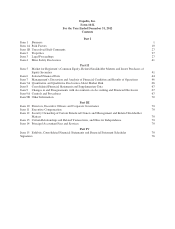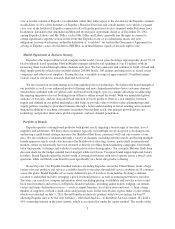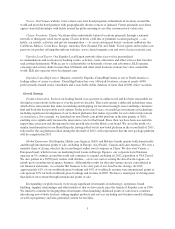Expedia 2012 Annual Report Download - page 12
Download and view the complete annual report
Please find page 12 of the 2012 Expedia annual report below. You can navigate through the pages in the report by either clicking on the pages listed below, or by using the keyword search tool below to find specific information within the annual report.Our scale of operations enhances the value of technology innovations we introduce on behalf of our
travelers and suppliers. We believe that our size and scale affords the company the ability to negotiate
competitive rates with our supply partners, provide breadth of choice and travel deals to our traveling customers
through an increasingly larger supply portfolio and creates opportunities for new value added offers for our
customers such as our loyalty programs. The size of Expedia’s worldwide traveler base makes our sites an
increasingly appealing channel for travel suppliers to reach customers. In addition, the sheer size of our user base
and search query volume allows us to test new technology very quickly in order to determine which innovations
are most likely to improve the travel research and booking process, and then roll those features out to our
worldwide audience in order to drive improvements to conversion.
New Channel Penetration. Today, the vast majority of online travel bookings are generated through typical
desktop and laptop computers. However, technological innovations and developments are creating new
opportunities including travel bookings made through mobile devices. In the past few years, each of our brands
made significant progress creating new mobile websites and mobile/tablet applications that are receiving strong
reviews and solid download trends. In 2010, we bought a leading travel application company called Mobiata®
which is responsible for several top travel applications, such as FlightTrackTM, FlightTrack ProTM and
FlightBoardTM, and is now integrated into Brand Expedia. We believe mobile bookings present an opportunity
for incremental growth as they are typically completed within one day of the travel or stay which is a much
shorter booking window than we have historically experienced via more traditional online booking methods.
During the last year, customers’ behaviors and preferences on tablet devices began to show differences from
trends seen on smartphones. For example, the booking window on a smartphone typically is much shorter than
the emerging trend on the tablet device and historical average on a desktop or laptop. We have a stated goal of
booking 20% of our transactions through mobile devices before the end of 2014.
Virtually all of our leisure brands continue to conduct experiments with ‘daily deals’ and social media as
part of our efforts to drive business through new distribution channels. We believe daily deals may represent
incremental travel bookings as it typically represents an impulse purchase compared to historical travel
purchasing activity which tends to be a highly considered and deliberate transaction. In addition, we anticipate
the importance of social media channels to consumers and to our industry to increase over time. It is our intention
to grow our ‘social’ efforts alongside this trend.
Merchant and Agency Business Models
We make travel products and services available both on a stand-alone and package basis, primarily through
two business models: the merchant model and the agency model. Under both models, we facilitate the booking of
hotel rooms, airline seats, car rentals and destination services from our travel suppliers. Under the merchant
model, we are the merchant of record. Under the agency model, the travel supplier is the merchant of record.
During 2012, we introduced the Expedia Traveler Preference (“ETP”) program that enables much closer
integration of the agency hotel product with our core merchant offering. Specifically, for participating hotels, we
will be able to offer customers the choice of whether to pay Expedia in advance (Expedia Collect) or pay at the
hotel at the time of the stay (Hotel Collect).
For transactions where we act as merchant of record, we generally have certain latitude to establish prices
charged to travelers (as compared to agency transactions). Also, we generally negotiate supply allocation and
pricing with our suppliers, which often enables us to achieve a higher level of net revenue per transaction as
compared to that provided through the agency model. Today, the majority of our merchant revenue primarily
relates to hotel bookings. As we roll-out the ETP program globally, we believe it will likely drive faster growth
in our agency hotel business which could result in our blended hotel margins trending down over time.
Through the introduction of the ETP program, we expect any distinction between the “agency-model” and the
“merchant-model” to blur over time.
Through our Expedia-branded websites, travelers can dynamically assemble multiple component travel
packages in a single transaction at a lower price as compared to booking each component separately. Packages
6
























